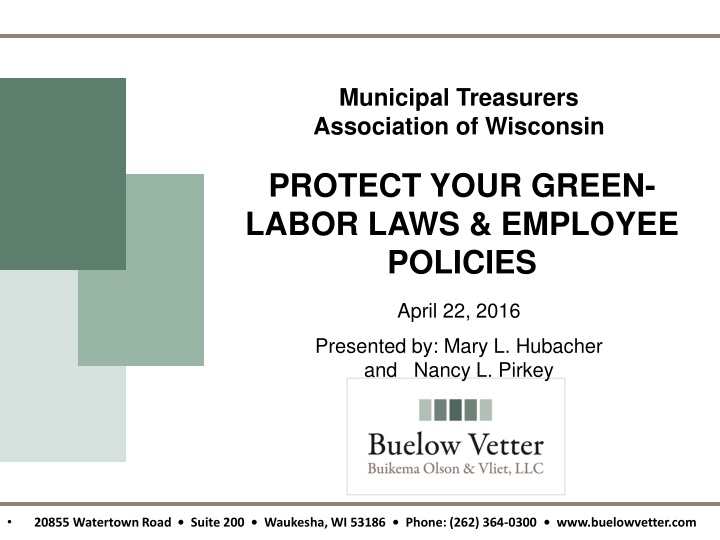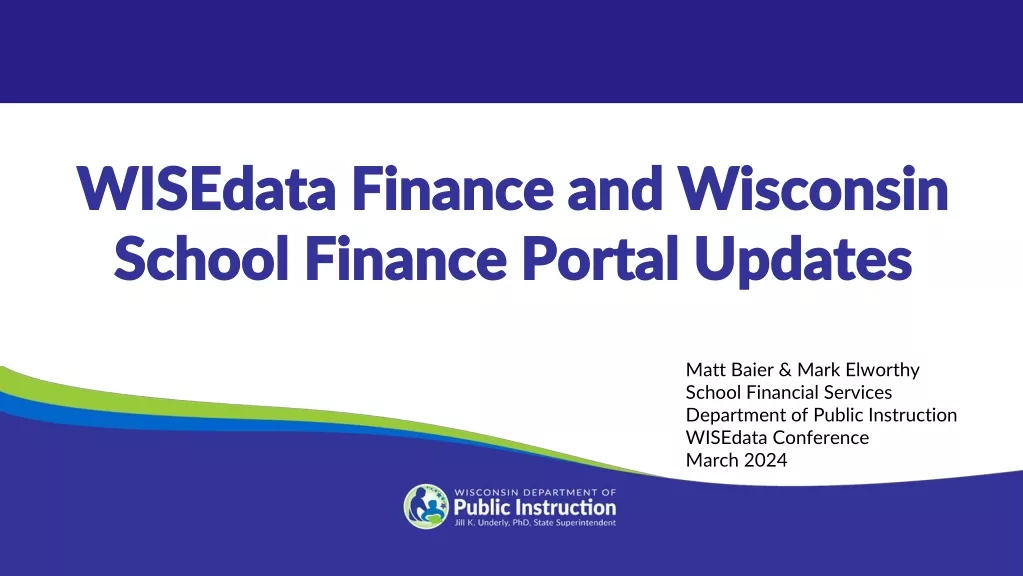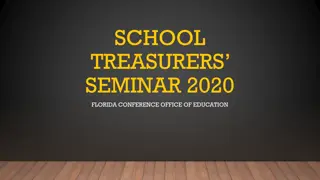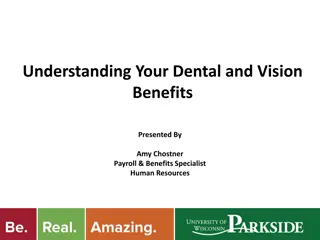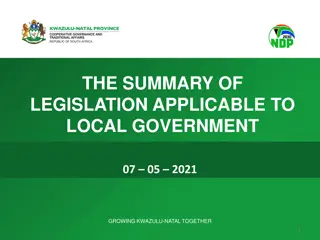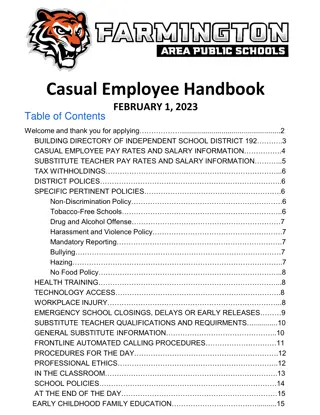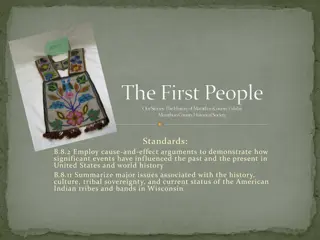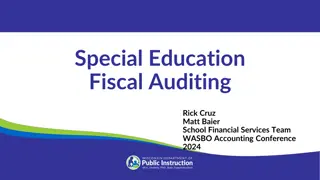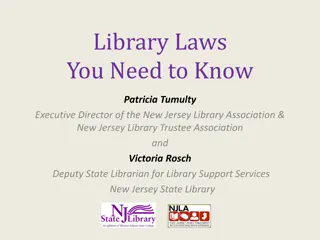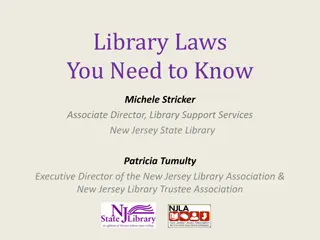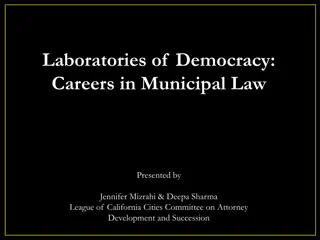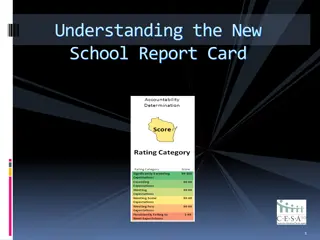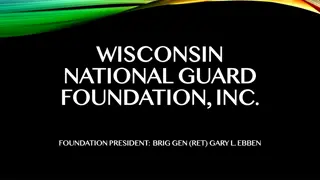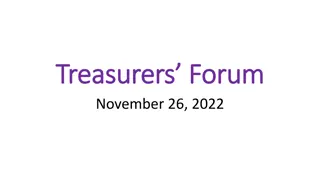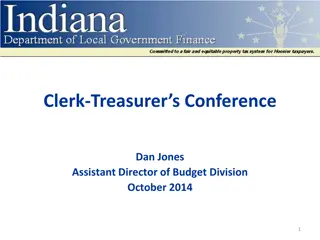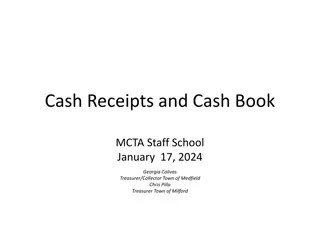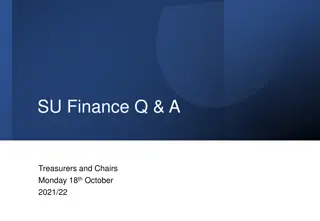Developing an Effective Employee Handbook for Municipal Treasurers Association of Wisconsin
This presentation by Mary L. Hubacher and Nancy L. Pirkey covers the importance of developing an employee handbook, including topics like fair treatment of employees, communication of expectations, and creating a resource for employees. It discusses the necessity of handbooks in both union and non-union environments, the employment-at-will doctrine, and whom the handbook should apply to. The process of reviewing existing policies, obtaining consensus from management, and gaining formal approval for the handbook is also emphasized.
Download Presentation

Please find below an Image/Link to download the presentation.
The content on the website is provided AS IS for your information and personal use only. It may not be sold, licensed, or shared on other websites without obtaining consent from the author.If you encounter any issues during the download, it is possible that the publisher has removed the file from their server.
You are allowed to download the files provided on this website for personal or commercial use, subject to the condition that they are used lawfully. All files are the property of their respective owners.
The content on the website is provided AS IS for your information and personal use only. It may not be sold, licensed, or shared on other websites without obtaining consent from the author.
E N D
Presentation Transcript
Municipal Treasurers Association of Wisconsin PROTECT YOUR GREEN- LABOR LAWS & EMPLOYEE POLICIES April 22, 2016 Presented by: Mary L. Hubacher and Nancy L. Pirkey 20855 Watertown Road Suite 200 Waukesha, WI 53186 Phone: (262) 364-0300 www.buelowvetter.com
TOPICS TO BE COVERED o Developing an Employee Handbook o Family and Medical Leave Act (FMLA) o Wage and Hour Issues o Personnel Audits
DEVELOPING AN EMPLOYEE HANDBOOK
DEVELOPING AN EMPLOYEE HANDBOOK Why Are Handbooks Necessary? o Fair treatment of employees. o Communicate expectations to all employees. o Replace benefits and working conditions previously addressed in union contracts. o Resource for employees and supervisors to use. o Minimize potential claims. o Defense to a lawsuit.
DEVELOPING AN EMPLOYEE HANDBOOK Union vs. Non-Union Environment. o Is a handbook necessary for police, fire and transit employees? o What policies should be included in the employee handbook for union employees?
DEVELOPING AN EMPLOYEE HANDBOOK General Statement of the Employment-at-Will Doctrine. An employee may be fired at any time, for any reason, a poor reason, or no reason at all, so long as the discharge is not based on discrimination protected by state or federal law.
DEVELOPING AN EMPLOYEE HANDBOOK To Whom is the Handbook Applicable? o Non-union employees (restrictions may be created by individual contracts, civil service rules, ordinances, etc.) o All employees (additional restrictions may be created by collective bargaining agreement). o Prepare language on conflicts; consider mandatory subjects of bargaining; contractual right of management to make reasonable work rules.
DEVELOPING AN EMPLOYEE HANDBOOK o Review existing policies, ordinances, practices need statement on superseding nature of new handbook. o Should be uniform throughout all departments if there are unique issues by department, those should be referenced, or handled in work rules. o Build consensus from management and elected officials. o Handbook should be formally approved by elected body.
DEVELOPING AN EMPLOYEE HANDBOOK Issues to Avoid in Creating a Handbook. o Use language from expired collective bargaining agreements. o Change cover page and adopt another municipality s handbook. o Make promises or guarantees that are not necessary. o Fail to obtain support of elected officials.
DEVELOPING AN EMPLOYEE HANDBOOK Helpful Hints in Drafting Your Handbook. o Set the proper tone for the handbook. o All provisions must be drafted in layperson s (not attorney s) language. o The tenor of the provisions, while firm, should be understanding, cooperative, and accommodating. o All language should be clear and unambiguous. o Less is more; the handbook need not be as detailed and inclusive as a collective bargaining agreement.
HOW TO AVOID AN EMPLOYMENT CONTRACT Have a solid at-will disclaimer. In addition, disclaimers can include: The handbook is not intended to create nor should it be construed to constitute a contract. No individual manager or supervisor has authority to create a contract or any agreement contrary to the foregoing. The employer reserves the right to change the handbook with or without notice, in its discretion. No agreement or statement is binding on the employer unless it is in writing and approved by the elected body (city council, village board, town board, etc.). o
HOW TO AVOID AN EMPLOYMENT CONTRACT o Place at-will language in key sections: At the beginning (introduction). In sections relating to orientation periods, discipline, termination or any other section where there is potentially contractual language. In a signed acknowledgement of receipt.
HOW TO AVOID AN EMPLOYMENT CONTRACT o Avoid terms like permanent, probationary, seniority, cause, and just cause. In addition: Avoid language concerning long-term employment, permanent employment, uninterrupted employment, or continued employment as long as a job is done well. Use introductory or orientation period instead of probationary period of employment. Avoid stating that employees will be terminated only for cause or for good cause, and do not use these concepts elsewhere.
HOW TO AVOID AN EMPLOYMENT CONTRACT o Avoid using the words shall and will in connection with actions the employer will take unless you outline the exceptions. Instead use the word may. o Avoid promises or guarantees unless you mean to enforce them. o Avoid the temptation of assuring employees in writing that they will be treated fairly or in good faith. o Carefully limit the rights and benefits that seniority confers upon employees, and expressly reserve the right to consider skill and ability in making layoff decisions.
HOW TO AVOID AN EMPLOYMENT CONTRACT o Be suspect of provisions requiring that an employee give advance notice of specified duration prior to quitting. o An employee s promise in this regard may be deemed consideration for which an employee can expect something in return. o Delete policies that guarantee a formal, periodic job evaluation process. o Be careful with progressive discipline policies.
HOW TO AVOID AN EMPLOYMENT CONTRACT o Tie your introductory period to something other than continued employment, such as: Eligibility for benefits. Initial performance evaluation. Training. o Reserve discretion To deviate from policies where appropriate. To change policies at any time, with or without notice. To interpret policies. To determine when application of a general policy is not appropriate.
DEVELOPING A HANDBOOK o Gather sample language or handbooks but do not use them unless you know: What the policy is for. Whether the policy is legal. Whether the policy reflects your municipality. Whether the policy is complete. Whether the policy is well done.
ORGANIZING A HANDBOOK o Use logical organization Group similar policies together. Number the sections for reference. Cross-reference related policies. Provide a table of contents or index. Use appendices or references to other policies and guidelines for additional information FMLA fact sheets. Benefit SPDs. Sample forms. o
ORGANIZING A HANDBOOK o Show dates Date policy or handbook was initially adopted. Last revision date.
MAXIMIZING HANDBOOK EFFECTIVENESS o Obtain written acknowledgement Receipt of Handbook. Key policies (e.g., harassment, conflict of interest, electronic communications). At-will status.
MAXIMIZING HANDBOOK EFFECTIVENESS o Train all employees on policies Be sure that all new employees (including temporary) receive copies of policies and applicable training. Retrain annually on key policies. Review, revise and reissue key policies annually.
MAXIMIZING HANDBOOK EFFECTIVENESS o Train supervisors Meet with supervisors regarding critical sections of handbook and their meaning (together if possible). Identify/discuss need for consistency in application and provide for consultation procedures to address consistency issues.
SAMPLE POLICIES FOR HANDBOOKS
INTRODUCTION SECTION o Purpose o Disclaimer Statement o Mission Statement
EMPLOYMENT POLICIES SECTION o Equal Employment Opportunities o Employees with Disabilities o Harassment Policy o Employment Verification o Personnel Records o Orientation (or Training) Period o Concealed Carry
EMPLOYMENT POLICIES SECTION o Job Classifications o Hours of Employment o Compensation o Overtime Pay/Compensatory Time for Non-Exempt Hourly Employees o Compensatory Time for Exempt Salaried Employees o Payroll Deductions o Attendance o Snow Day Attendance o Performance Appraisals/Evaluations o Layoff and Recall
EMPLOYEE CONDUCT SECTION o Conflict of Interest o Political Activity o Gift and Gratuities o Dress Code/Personal Attire o No Solicitation or Distribution o Confidentiality o Nepotism
EMPLOYEE BENEFITS SECTION Vacations Holidays Sick Leave Family/Medical Leave Act (FMLA) Funeral Leave Jury Duty Health Insurance Dental Insurance Worker s Compensation Life Insurance Pension Education Reimbursement Uniform Allowance o o o o o o o o o o o o o
WORKPLACE SAFETY SECTION o Ensuring a Safe Workplace o Safety Rules o Physical Examinations o Work Rules o Drug and Alcohol Free Workplace o Drug and Alcohol Testing
TECHNOLOGY AND COMMUNICATION SECTION o Telephone Usage o Electronic Communications o Use of Social Media o Acceptable Use of Technology
EMPLOYEE DISCIPLINE SECTION o Discipline o Code of Conduct o Grievance Procedure
ACKNOWLEDGMENT FORM o Acknowledges Employment Status o Acknowledges Receipt of Handbook o Acknowledges Employee Must Comply With Policies Contained in Handbook
FAMILY AND MEDICAL LEAVE ACT (FMLA)
EMPLOYERS COVERED BY FMLA LAWS Employers Covered. o Only employers with 50 or more employees are covered by the Wisconsin and Federal FMLA laws. o Confusion exists over whether every public employer is covered, regardless of size. o Wisconsin FMLA requires that employers with 25 or more employees post a notice explaining their policies on family and medical leave.
DEFINING THE NUMBER OF EMPLOYEES FOR FMLA COVERAGE Federal o 50 employees for at least 20 calendar weeks. o If employee s name appears on the payroll, they will count toward 50 employees for coverage, even if no compensation is paid in that week. Wisconsin o 50 employees must be permanent employees. o Examine usual personnel recordkeeping practices to determine if employee counts. o Include employees on leave (whether paid or unpaid) or on layoff.
EMPLOYEES ELIGIBLE FOR FMLA LEAVE Federal and Wisconsin FMLA laws use different criteria for determining eligibility for FMLA leave. Wisconsin o 52 consecutive weeks of employment. o 1,000 hours paid in those 52 consecutive weeks. Federal o 12 total months of employment. o 1,250 hours worked in the preceding 12 months.
FEDERAL VS. STATE FMLA REQUIREMENTS o The Wisconsin FMLA and Federal FMLA laws create different legal standards for coverage, amount of leave, benefits, forms, etc. o Where the federal and state laws regulate the same subject area, the law that is more liberal from the employee s perspective will apply. o Where only one law applies, there is no need to coordinate FMLA laws.
FMLA LEAVE ENTITLEMENT Federal A total of 12 weeks in a 12 month period for: o Birth or adoption of the employee s child; o The employee s own serious health condition; o Leave to care for the employee s parent, child or spouse who has a serious health condition; or o Leave due to a qualifying exigency because a family member is called to active duty.
FMLA LEAVE ENTITLEMENT Federal A total of 26 weeks in a single 12-month period for the parent, spouse, child or next of kin who is injured or recovering from an injury incurred while on active military duty. o The 12 month period is not a calendar year. o The 12-month period runs from the first day the employee takes military injury leave. o Leave must be applied on a per-covered-service- member, per-injury basis.
FMLA LEAVE ENTITLEMENT Wisconsin FMLA leave must be applied on a calendar year basis. o 6 weeks per calendar year for the birth or adoption of the employee s child. o 2 weeks per calendar year for the employee s own serious health condition. o 2 weeks per calendar year to care for the employee s parent, child, spouse or domestic partner who has a serious health condition.
DEFINITION OF A YEAR FOR FMLA PURPOSES o The 12-month eligibility period must be a calendar year in Wisconsin. o Since Wisconsin requires that FMLA be taken on a calendar year basis, the Federal Regulations require that Federal FMLA also be taken on a calendar year basis.
FMLA LEAVE ENTITLEMENT Legal Standards o Federal definition vs. Wisconsin definition of a serious health condition. o What is a health care provider? o How is the employee needed to care for a parent, child or spouse? o Coverage under Federal FMLA and Wisconsin FMLA domestic partners, in- laws, etc.
DEFINITION OF A SERIOUS HEALTH CONDITION Wisconsin An illness or injury that requires: o Inpatient care; or o Outpatient care that requires continuing treatment by a health care provider.
DEFINITION OF A SERIOUS HEALTH CONDITION Federal An illness or injury that requires: o Inpatient care; or o Incapacity of more than 3 full calendar days and continuing treatment by a health care provider; or o Continuing treatment by a health care provider for a chronic long-term condition that, if left untreated, would likely result in incapacity for more than 3 calendar days.
CONTINUING TREATMENT Continuing treatment by a health care provider includes: o 2 or more visits/treatments by a health care provider; or o A single visit to a health care provider that results in a regimen of continuing treatment under the supervision of a health care provider (for example, medication, testing, or therapy).
CONTINUING TREATMENT o Under the Federal FMLA Regulations, the 2 visits must occur within 30 days of each other. o Under the Federal FMLA Regulations, the single visit to the health care provider must occur within the first 7 days of incapacity. o The Federal FMLA Regulations require an in-person visit to the health care provider.
DEFINITION OF A SERIOUS HEALTH CONDITION o A work-related injury is a serious health condition under the Federal FMLA but not the Wisconsin FMLA. According to the Department of Labor, the employer should run worker s compensation concurrently with Federal FMLA leave.
NOTICE REQUIREMENTS Federal o Foreseeable Leave Can require up to 30 days notice. o Unforeseeable Leave As soon as practicable. o Under federal law, an employer can enforce its general policies for calling in sick or taking leave.
NOTICE REQUIREMENTS Wisconsin o Family Leave Scheduled in a reasonable and practicable manner. o Medical Leave Scheduled so that it does not unduly disrupt the employer s operations with advance notice given in a reasonable and practicable manner.
MEDICAL CERTIFICATION o When can you mandate it and for whom? o State and federal agencies have separate (and conflicting) forms for medical certification. o Additional certification and recertification o Intent to return to work. o Fitness for duty.
